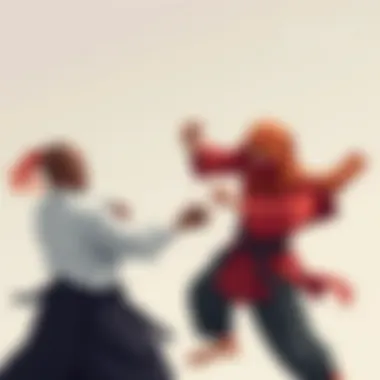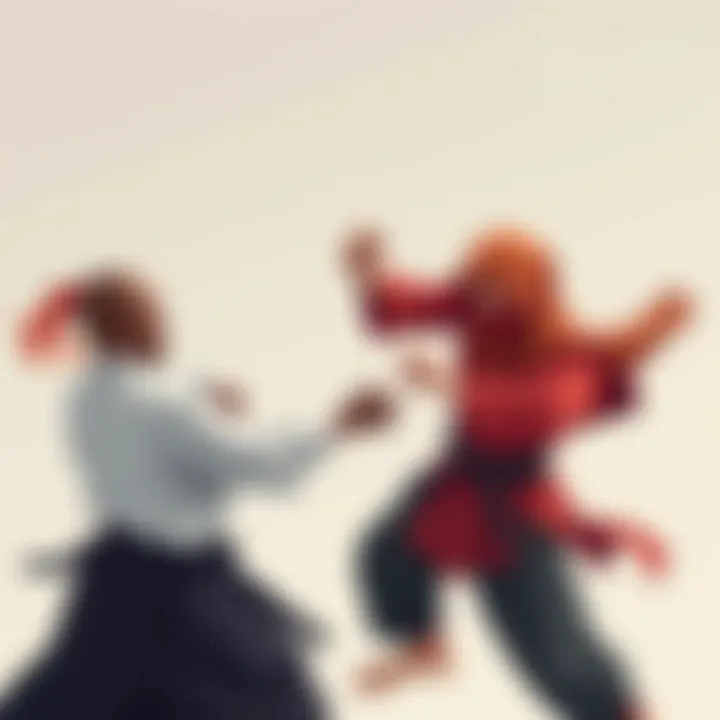The Silat Warrior: Exploring Art and Philosophy


Intro
Silat is more than just a martial art; it's an embodiment of rich cultural heritage that whispers tales of the warriors past and present. Originating from the lush landscapes of Southeast Asia, particularly Indonesia and Malaysia, it's steeped in history, influence, and profound philosophical beliefs. The journey of a Silat warrior is paved with discipline, respect, and a continuous quest for spiritual growth. As practitioners delve into the various techniques and styles, they often find themselves not only honing their physical prowess but also engaging in a mental and emotional saga that propels them towards personal transcendence.
This article aims to explore the multifaceted layers of Silat, providing insights into its historical importance, techniques, and the underlying philosophies that guide its practitioners. By dissecting its complex structure, we will not only uncover Silat's roots but also begin to appreciate it as a way of life—one that calls forth a deep respect for self and others. As we continue, this exploration will shed light on how ancient practices can still resonate in today’s fast-paced world.
Understanding Silat
Silat is a multifaceted martial art, deeply embedded in the cultural fabric of Southeast Asia. Grasping its essence is not merely about learning techniques but involves a dive into its historical roots and the philosophy that underpins its practice. Understanding Silat provides a pathway to appreciate the nuances of discipline, respect, and the spiritual journey that practitioners embrace. The importance of this understanding cannot be overstated, as it extends beyond physical training; it molds character and builds resilience.
Historical Origins
The origins of Silat can be traced back centuries, primarily within the regions of Indonesia, Malaysia, and the Philippines. Each locality contributes its unique history to the development of this art. It is said that Silat was influenced by ancient Indian martial arts; this connection highlights a rich cultural interchange. Early practitioners often used Silat for self-defense and as a means to preserve traditional values. This martial art evolved through the ages, influenced by local customs, colonial encounters, and social changes.
Cultural Significance
Silat is more than a combat sport; it's a celebration of identity and heritage. In many communities, the practice of Silat is tied to cultural ceremonies, weddings, and festivals, where it showcases not only the physical prowess of the warriors but also the rich storytelling traditions of the culture. Through the movements and routines, practitioners pass on significant lessons about values, including honor and integrity.
Regional Variations
Silat has branched out into various distinctive styles, each with its own flavor and focus.
Malay Silat
Malay Silat is recognized for its elegant movements and graceful footwork. It emphasizes finesse over brute strength, making it a popular choice among practitioners who value artistry in martial arts. The intricate techniques of Malay Silat often combine strikes with dance-like motions, allowing practitioners to showcase their skills in visually stunning ways. A unique characteristic of Malay Silat is its focus on self-defense, which instills confidence and promotes peace within communities.
Indonesian Silat
Indonesian Silat stands out for its diversity in techniques and approaches. With numerous styles, it offers practicality in both sport and self-defense contexts. One key feature of Indonesian Silat is its combat-oriented strategies, which can be traced back to tribal warfare tactics. As such, it fosters a strong sense of community, bringing together different ethnic groups under the broader umbrella of martial arts. The adaptability of Indonesian Silat makes it an appealing choice for those looking to understand the broader context of Silat.
Filipino Silat
Filipino Silat is gaining prominence, known for its focus on weapons training alongside empty-handed techniques. It infuses its practice with the rich history of the Philippines, where martial arts often need to be practical for self-defense against external threats. A standout quality of Filipino Silat is its incorporation of rapid strikes and joint locks, which promotes agility and efficiency. This aspect makes it particularly beneficial for those who are prepared to train rigorously and test their skills in varied scenarios.
The Art of Silat
The Art of Silat possesses a profound significance that extends beyond mere physical confrontation. It represents a synthesis of technique, philosophy, and culture, which together cultivate the essence of a Silat warrior. By understanding the techniques, movements, and tools that this martial art employs, one can appreciate not only the physical prowess required but also the mental fortitude and discipline that characterize a true practitioner.
Silat is not just a means to defend oneself; it is an embodiment of a lifestyle that intertwines respect, mental clarity, and spiritual grounding. Such elements contribute to the warrior’s overall development, allowing for a deeper connection with their heritage and a better understanding of their own capabilities.
In this section, we will dissect various techniques and movements fundamental to Silat, as well as the traditional weapons that are integral to this martial art. This exploration aims not just to inform, but to inspire further interest and exploration in the rich culture that surrounds Silat.
Techniques and Movements
Strikes and Kicks
Strikes and kicks form the backbone of Silat’s fighting arsenal. A key characteristic of these techniques is their adaptability; a warrior can employ strikes from various angles while maintaining optimal balance. This versatility allows for rapid responses to unforeseen movements from opponents. The power behind strikes and kicks in Silat isn’t merely physical strength; it involves timing and precision.
One unique feature of these strikes is their fluidity in execution, enabling practitioners to transition smoothly between different techniques. This fluidity gives Silat a distinct flavor compared to other martial arts, which often emphasize more rigid forms of movement. However, the downside may be the risk of overextending oneself in a strike, which can lead to openings for counter-attacks. Furthermore, not all practitioners may develop the required muscle memory to execute these techniques efficiently.


Joint Locks and Throws
Joint locks and throws are crucial aspects of Silat that emphasize control over the opponent. The key characteristic here is leverage; practitioners utilize an opponent’s force against them, making it highly effective regardless of size or strength differences. This aspect of Silat promotes the concept that skill can surpass mere brute force—especially when executed correctly.
A unique feature of joint locks in Silat is their capacity for both offensive and defensive applications. This dual purpose adds a layer of strategy to engagements. While joint locks can immobilize or control an opponent, they also require extensive knowledge and practice to perform safely. More downside to this technique is that improperly applied locks can result in injury, both to the practitioner and the opponent.
Defensive Maneuvers
Defensive maneuvers in Silat are foundational for any practitioner wishing to enhance their combat skills. A notable aspect of these maneuvers is their emphasis on the anticipation of incoming attacks. Warriors learn to read opponents’ stances and body movements, allowing timely evasions or counters. This proactive approach is essential not only in sparring but in real-world scenarios.
The strength of defensive maneuvers lies in their ability to create openings for counter-attacks. However, one drawback could be that if a practitioner becomes too focused on defense, they might miss opportunities to engage proactively. Also, mastering defensive techniques demands consistent practice to build the necessary reflexes.
Weapons in Silat
Traditional Weapons
Traditional weapons hold a special place in the art of Silat, offering a glimpse into its historical context and cultural significance. Among these, the kris, a traditional dagger with a distinct wavy blade, stands out due to its intricate designs and symbolism. These weapons are not merely tools for combat; they represent the rich heritage and stories of the warriors who wielded them.
The unique features of traditional weapons often dictate their usage in combat. For example, the kris’s asymmetric blade allows for unconventional cutting angles that can catch opponents off-guard. However, these weapons come with a certain level of responsibility and require an understanding of respect and discipline to wield effectively.
Weapon Training Techniques
Weapon training techniques in Silat are as refined as the weapons themselves. One key characteristic is the structured nature of this training, designed to instill both physical and mental discipline. Practitioners learn the proper handling, strikes, and defensive techniques associated with each weapon, ensuring a well-rounded skill set.
A unique feature of weapon training techniques is their incorporation of forms, or silat langkah, which combine footwork and weapon movement into a fluid sequence. This enhances coordination and helps in integrating weapon skills with unarmed tactics. However, mastering these techniques can be time-consuming, and novices may feel overwhelmed by the initial complexity.
Weapon Handling and Philosophy
The philosophy behind weapon handling in Silat goes beyond simple mastery of technique; it incorporates respect for the weapon and understanding of its purpose. Practitioners are taught to view weapons not just as tools for fighting but as extensions of themselves. This core principle nurtures a deeper connection between the warrior and their craft.
An essential aspect of this philosophy is the balance between aggression and composure. While weapons can empower a fighter, the understanding that they come with responsibilities cannot be overstated. The downside is that not every practitioner may come to grasp this philosophy fully, and some may struggle with their weapon handling, leading to a disconnect between intent and action.
"In the hands of a true warrior, a weapon is not merely an object, but a reflection of discipline, respect, and mastery."
Through examining these techniques, movements, and weaponry within the Silat discipline, we derive a profound understanding of what it means to be a Silat warrior. With dedication and respect, each aspect enriches the practitioner's path, fostering a robust inner and outer journey.
Philosophy Behind the Warrior
In the world of Silat, the philosophy extends far beyond mere physical combat. It enshrines a rich tapestry of values that shape not only the fighter's abilities but also their character and interactions with the world. The essence of being a Silat warrior is anchored in a triad of principles: discipline, spirituality, and the warrior ethos. Each of these elements is intertwined, creating a holistic approach to both martial skill and personal development.
Discipline and Respect
Discipline is the bedrock of any martial art, but in Silat, it takes on additional layers of meaning. The rigorous training regimes are not just about honing fighting techniques; they also instill a sense of responsibility and commitment. Practitioners are taught to respect their teachers, peers, and even their opponents. This mutual respect cultivates a healthy environment for learning and growth.
In practical terms, discipline manifests in various forms:
- Consistency in Practice: Regular training is crucial. Engaging consistently allows fighters to refine their techniques and maintain peak physical condition.
- Adherence to Tradition: Silat is steeped in cultural heritage. Respecting the traditions of the art means honoring its history and context.
- Self-Control: Knowing when to apply skills in combat, and when to refrain, can often define a true warrior.
By internalizing discipline and respect, warriors develop not just as fighters but as well-rounded individuals.
Spirituality and Mindfulness


The journey of a Silat practitioner is frequently woven with threads of spirituality. This aspect is not about religious doctrine but is more about cultivating a profound connection with oneself and the environment. The tenets of mindfulness permeate training sessions, urging participants to be present in their movements and aware of their surroundings.
Practices often involve:
- Meditation: A common tool in Silat training, meditation enhances focus, calmness, and clarity. It prepares warriors to face both physical challenges and life's adversities with equanimity.
- Breathing Techniques: Essential for managing physical exertion and mental stress. Proper breathing helps maintain energy levels and composure.
- Connection with Nature: Many Silat schools emphasize training in natural settings, reinforcing a connection between the individual and the larger universe.
This focus on spirituality and mindfulness equips warriors with mental resilience and emotional intelligence, essential traits for navigating the complexities of life.
The Warrior Ethos
Every guardian of Silat embodies a warrior ethos that encompasses courage, honor, and the pursuit of excellence. This isn't mere bravado; it’s a commitment to uphold certain standards and ideals both on and off the mat. A Silat warrior stands as a reflection of their culture and values, often seen as a protector of their community.
Key aspects include:
- Courage: Facing challenges head-on, whether in combat or personal life, is at the heart of the warrior’s journey.
- Honor: Fighting with integrity and respect for others reinforces the moral fabric of the art.
- Continuous Improvement: The quest for mastery is perpetual, encouraging practitioners to forge their path toward greater understanding and skill.
The Silat warrior is not just defined by their ability to execute techniques but by their commitment to the deeper values that underlie their practice.
Training as a Silat Warrior
Training in Silat is not merely a routine; it’s a lifestyle that fosters a range of skills and qualities necessary for a warrior. This section explains why training, both physically and mentally, is a cornerstone of the Silat experience. Through rigorous practice and philosophy, practitioners can embody the spirit of a true Silat warrior.
Physical Conditioning
Physical conditioning is at the heart of every Silat warrior’s training regimen. It's not just about looking fit; rather, it encompasses various components vital for developing a well-rounded martial artist.
Strength Training
Strength training is fundamental for any Silat practitioner. It prepares the body for the physical demands of the art, enhancing muscle power and promoting injury prevention. Strong muscles contribute directly to effective strikes and the ability to perform complex movements with ease.
One characteristic that stands out about strength training in Silat is its focus on functional strength. Unlike traditional gym workouts that might prioritize aesthetics, Silat strength training emphasizes real-world applicability. This characteristic aligns perfectly with the martial art's core principle of efficiency in movement.
However, too much emphasis on strength without balancing other aspects of physical conditioning, such as flexibility, can lead to a rigid performance. Therefore, it’s crucial for warriors to integrate strength training with other modalities like endurance and flexibility for holistic development.
Endurance and Flexibility
Endurance and flexibility are two sides of the same coin in Silat training. Endurance allows practitioners to sustain energy during long sessions or fights, whereas flexibility ensures that their bodies can adapt to the intricate techniques of Silat.
A notable feature of this training is the way it enhances overall body control. Greater flexibility contributes not just to executing high kicks or intricate maneuvers, but also to avoiding injuries during confrontations. Moreover, maintaining endurance can be the difference between fatigue and control amidst a challenging sparring match.
The downside of focusing solely on flexibility could manifest in a lack of strength, hence, a varied approach is vital. It’s about finding that sweet spot, ensuring that a warrior can bend without breaking, and endure without yielding, resulting in a balanced martial artist.
Mental Preparation
Training oneself mentally is equally crucial as physical conditioning. The mind's power often surpasses physical prowess, especially in a demanding discipline like Silat.
Focus and Concentration
Focus and concentration enable Silat practitioners to raise their performance to new heights. They help martial artists remain present, attuned to their surroundings, and able to quickly process information during a confrontation. This heightened state of awareness leads to better decision-making.
A key aspect of building focus is the practice of meditation or breathing exercises, which provide a greater sense of tranquility amidst chaos. The inclusion of these practices is a wise choice, as they can help practitioners cultivate mental clarity and calmness under pressure, especially in competitive settings or high-stress training environments.


The potential pitfall here lies in overthinking. Engaging too deeply with thoughts can lead to hesitation, which is detrimental in any martial art. Thus, mastering the balance between focus and relaxation becomes paramount to a Silat warrior’s mental success.
Visualization Techniques
Visualization techniques serve as a powerful tool in preparing the mind. They enable practitioners to mentally rehearse movements, sparring scenarios, or competition strategies, resulting in a higher likelihood of success when faced with real situations.
This unique feature of visualization could range from imagining oneself executing a perfect technique to mentally navigating through a sparring match, reinforcing muscle memory.
Yet it’s essential to disclaim that visualization should be complemented with physical practice. When the two work in tandem, they reinforce each other effectively, resulting in a warrior who not only thinks like a fighter but also moves like one.
Sparring and Practical Applications
Sparring serves as the crucible for testing the skills acquired through training. It’s one thing to practice movements in isolation, quite another to apply them in dynamic exchanges against an opponent. Here, practitioners learn to adapt, improvise, and implement their training in real-time scenarios, solidifying their understanding of Silat.
Through sparring, various techniques can be explored, offering valuable insights into both strengths and weaknesses while refining timing and distance control. This component transforms theoretical knowledge into practical application, preparing the warrior for actual confrontations. Ultimately, training as a Silat warrior embraces a wholistic approach, intertwining physical conditioning and mental fortitude, laying a strong foundation for any aspirant.
Silat in Modern Context
The evolution of Silat in the contemporary world showcases its adaptability and relevance beyond traditional settings. As time marches on, Silat has found its place not only as a martial art but also as a cultural symbol that resonates across global boundaries. Particularly for the younger generation, this connection with a rich ancestry provides a sense of identity while promoting martial ethics and physical fitness. Today, when we speak of Silat, it entails not just the technical aspect but also the collective community fostering spirit.
In our globalized society, Silat serves as a bridge, linking cultures and promoting understanding through the sharing of techniques and philosophies. The participation of practitioners in international competitions merges traditional skills with modern athleticism, challenging preconceptions and enhancing the art's profile. Moreover, workshops and clinics around the world ensure that the teachings and nuances of Silat are sustained and passed onto emerging practitioners.
Silat in Martial Arts Competitions
Martial arts competitions have become a battleground of ideas where different styles vie for recognition, and Silat has made its mark. The presence of Silat in these events underscores its technical sophistication and athletic performance. Tournaments not only spotlight martial prowess, but they also serve as vibrant showcases of culture. Contestants perform intricate movements that reveal the art’s depth and history, turning the mat into a testament to dedication and tradition. Competitions, including the Southeast Asian Games, allow Silat to step into international limelight, drawing new enthusiasts who may not have otherwise engaged with the art. The spirit of competition drives improvement, fueling a cycle of innovation in techniques that continue to evolve.
Influence on Popular Culture
Film and Television
The cinematic landscape has embraced Silat, portraying it as a captivating blend of combat and storytelling. Movies like "The Raid" not only highlight the martial art's breathtaking maneuvers but also hook audiences with gripping narratives. Silat's portrayal in film emphasizes its agility, rhythm, and tactical elegance. These visuals resonate with viewers, establishing a romanticism around the warrior spirit that lies within the Silat philosophy. However, it’s essential to recognize that while films often dramatize techniques for theatrical effect, the essence of Silat remains intact, serving to inspire newcomers to join the ranks of practitioners.
Social Media and Online Presence
Social media platforms have transformed the way martial arts, including Silat, reach audiences. Through YouTube tutorials, Instagram posts, and TikTok challenges, practitioners are now sharing techniques and lessons on a global scale in ways never imagined before. This online visibility cultivates a community vibe and enables novices to connect with experienced masters, fostering an environment of continuous learning. While the instant appeal of social media can sometimes lead to oversimplification of techniques, the potential for immersive and interactive learning experiences is unmatched. Online forums and discussion groups also gather enthusiasts, creating a sense of belonging and collaboration.
Global Community and Workshops
As modern Silat flourishes, a global community of practitioners is also emerging. Workshops and seminars, held in various parts of the world, allow enthusiasts from diverse backgrounds to come together in a shared pursuit of mastery. These events not only focus on the physical training involved but also delve into the philosophy and tradition that underpin Silat. The exchange of ideas and experiences enriches everyone involved, laying a foundation for a more profound understanding of this martial art. Notably, participating in global gatherings fosters a sense of camaraderie and respect among practitioners, resonating with the core values Silat embodies.
In summary, the discussion of Silat in the modern context unveils a narrative of growth, cultural significance, and community development. This art form has successfully woven itself into the fabric of contemporary society, proving that age-old traditions can adapt and thrive in an ever-changing world.
The End
In wrapping up this exploration of Silat, we can recognize the profound importance of understanding the art and philosophy that underpin this martial discipline. Far from being just a series of combat techniques, Silat embodies the values of discipline, respect, and spirituality — elements that interweave to create a holistic path for practitioners.
The Legacy of Silat Warriors
The legacy of Silat warriors is rich and layered. These individuals stand as living testaments to centuries of tradition, cultural pride, and spiritual enlightenment. Not only do they carry forward the techniques handed down through generations, but they also serve as cultural ambassadors.
- Cultural Preservation: Each Silat practitioner contributes to preserving not just the moves, but the stories and customs associated with this martial art. This preservation is crucial, as it ensures that the teachings are not lost to modernity. They pass on unique anecdotes about their masters and the historical significance of their arts.
- Community Building: Silat warriors often engage with their communities, teaching younger generations the importance of respect and discipline. Through workshops and demonstrations, they inspire others to embrace the art, fostering a sense of unity and shared identity.
- Personal Growth: Beyond physical prowess, many warriors find that their journey through Silat molds their character. The rigorous training, mental focus, and philosophical teachings instill strong values such as patience and humility, traits that extend beyond the training mat into daily life.
“To practice Silat is to embark on a journey of self-discovery; every kick and every opponent is a reflection of oneself.”
Embracing the art of Silat allows individuals to not only enhance their physical capabilities but also enrich their minds and spirits. As we conclude this examination, it's clear that the impact of Silat warriors reverberates well beyond the dojo, shaping cultural landscapes and individual lives. In a world filled with distractions and complexities, the foundational lessons of Silat remind us of the balance between mind, body, and spirit, making this martial art not just a skill, but a vital life philosophy.
Performance enhancement through discipline, alongside social responsibilities, positions these warriors as critical figures in a rapidly changing world. Their legacy is not only in the techniques they master but in the values they uphold. These are the cornerstones of the warrior ethos, ensuring that Silat remains a living, breathing tradition for generations to come.







